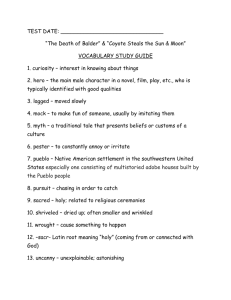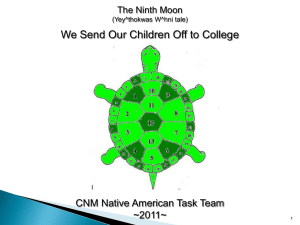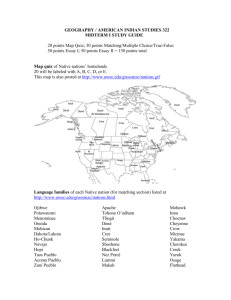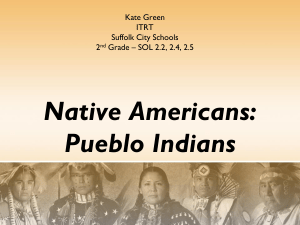American Educational Research Association
advertisement
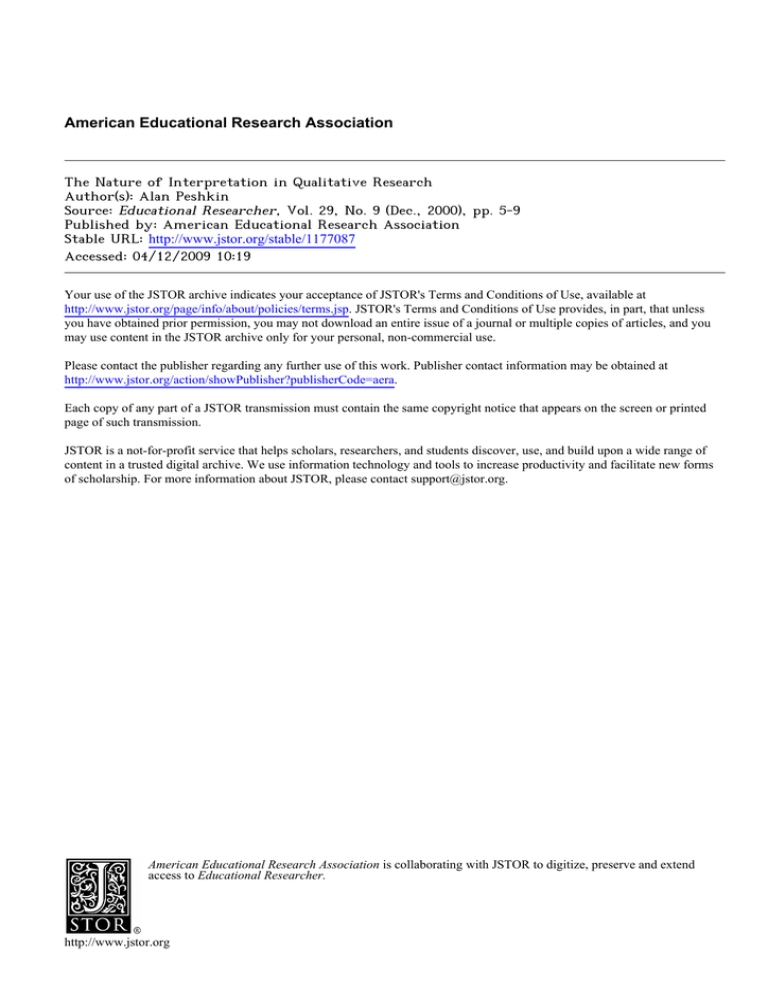
American Educational Research Association The Nature of Interpretation in Qualitative Research Author(s): Alan Peshkin Source: Educational Researcher, Vol. 29, No. 9 (Dec., 2000), pp. 5-9 Published by: American Educational Research Association Stable URL: http://www.jstor.org/stable/1177087 Accessed: 04/12/2009 10:19 Your use of the JSTOR archive indicates your acceptance of JSTOR's Terms and Conditions of Use, available at http://www.jstor.org/page/info/about/policies/terms.jsp. JSTOR's Terms and Conditions of Use provides, in part, that unless you have obtained prior permission, you may not download an entire issue of a journal or multiple copies of articles, and you may use content in the JSTOR archive only for your personal, non-commercial use. Please contact the publisher regarding any further use of this work. Publisher contact information may be obtained at http://www.jstor.org/action/showPublisher?publisherCode=aera. Each copy of any part of a JSTOR transmission must contain the same copyright notice that appears on the screen or printed page of such transmission. JSTOR is a not-for-profit service that helps scholars, researchers, and students discover, use, and build upon a wide range of content in a trusted digital archive. We use information technology and tools to increase productivity and facilitate new forms of scholarship. For more information about JSTOR, please contact support@jstor.org. American Educational Research Association is collaborating with JSTOR to digitize, preserve and extend access to Educational Researcher. http://www.jstor.org The Nature in of Interpretation QualitativeResearch ALAN PESHKIN Thispaperaddressestheprocessof interpretation from a study of the academicachievementsof Native Americanyouth. It illuminates the relationshipof researcher subjectivityto themanydecision points that eachprocessof interpretationembodies.It also containsa counterpointof problematicsthatrevealswherealternativeinterpretivedecisionscouldhavebeenmade. EducationalResearcher,Vol. 29, No. 9, pp. 5-9 Practitionersof scienceare differentfrom artists in that they give primacyto logic and evidence,but the mostfundamental progressin scienceis achievedthroughhunch,analogy,insight, and creativity. -David Baltimore, Ivan R. Cottrell Professor of Molecular Biology, in TheNew Yorker, January27, 1997 Interpretation,in the sense relevantto hermeneutics,is an attemptto makeclear,to makesenseof an objectof study.... But how does one know that [an] interpretationis correct?Presumably because... what is strange, mystifying,puzzling, contradictoryis no longerso. --Charles Taylor,Professor of Philosophy, in Knowledgeand Valuesin Social and EducationalResearch his paper is about a journey of interpretation.' It presents a retrospective account of the unfolding course of ideas that I developed in a recent study of schoolcommunity relations. It also presents a series of metanarrative reflections on these ideas that I call "problematics."The journey and the problematics are complementary strands, together showing what underlies the researcher's process of interpretation, with its numerous occasions for interpolating and extrapolating, judgment-making and assuming, doubting and affirming. At the many crossroads of my interpretive journey,I made decisions that affected the meaning of old data, the new data I sought to collect, the ongoing substance of my thinking, and what eventually I would write. All this was done in the search for believably firm ground for interpretation. An important reason for reflecting on the development of an interpretation is to show the way a researcher's self, or identity in a situation, intertwines with his or her understanding of the object of the investigation. Rarely,except in highly controlled or consensually defined situations, can research be a simple form of record keeping and summary. More often, however, when it is unclear which interpreta- tion is correct, or whose, the very nature of the "problem" is open to question. Then, as Brown, Collins, and Duguid (1989) suggested in everyday inquiry, the "whole task" includes figuring out what the task is, as well as finding a solution to it. The interplay of subject and object, self and problem, is usually taken for granted or ignored in both qualitative and quantitative research. Yet the researcher's orientation and the definition of the situation cannot help but have ramifications for the way people are treated or thought of (e.g., as "subjects,"as "deviants,"or as analogous to computers). As Phillips (1996) suggested, researchers ought to give explicit attentionto the models of the phenomena that lie behind their researchprograms,not so that these models can be expunged but so that, like other aspects of research,they can become the objectsof criticism and conscious investigation.(p. 1013) What is even less well understood is the way that a developing interpretation and the identity or orientation of the researcherevolve over the course of a research project when this identity is not a settled affair.It is this process that I seek to describe here. My journey began in New Mexico where, aftervisiting as a tourist, I thought I had found a promising site for continuing my study of the school-community relationship. From several good possibilities in New Mexico for researchon this topic, I decided to find a school where Native American students are the majority.(HereafterI referto Native Americans as Indian, their most commonly used term for themselves.) At this time, I knew little more than that Pueblo Indians were people of two worlds, meaning that they were somehow involved in an Indian and a non-Indian world. What is it like to live in two worlds? I wondered. What does this mean? How is it done? I wasdeterminedto studythephenomenon PROBLEMATICS: of dualidentity.HadI thoughtthatIndiansoughtto live in two worlds,or thattheyshoulddoso in a certainway,I wouldhave knownthatI begantheshapingof myforthcominginterpretations with a particularstate of mind and its particularimplications.Believingthat I did not have such a state of mind, I imaginedthat I was, relativelyspeaking,truly open to learning. However,when I name the phenomenonof my study as ALAN PESHKINis a professor ofeducationat StanfordUniversity, CubberlyLasuen,StanfordUniversity,CA 94305-3096.His area of specializationis anthropologyof education. DECEMBER2000 5 "dual-worldidentity,"I have alreadybegun my interpretive journey.Thisnamingpointsto a relevantliterature;it identifies theexistingworkthatI must takeaccountof in somedefensible thepheway. Generallyless consciouslyknownto researchers, nomenonas namedand conceivedis probablyassociatedwith personalperspectives,dispositions,andfeelings-in a word, theirsubjectivity-thatalsowill bearon theinterpretive process. Wearenot indifferentto thesubjectmatterof our inquiries. To my questions about the nature and meaning of living in two worlds I brought certain inclinations from my previous researchthat would shape my study. For example, I am oriented to learning about high schools within the context of their community. I am convinced that knowledge of this context is necessary to understand what happens in any American school. Thus, I began my research with a substantive focus, the dual-world identity of Pueblo Indians, and with a particularinterest in the school-community relationship. Together,they composed my incipientfieldof study. After months of meeting people and visiting schools, I gained access to Indian High School, a Bureauof Indian Affairs boarding school that is administeredby Indian leadership and controlled by the 19 New Mexican Pueblo tribes. They are the school's community context. My incipient field of study now had a definite educationaland culturalcontext. While seeking school board approval to conduct my research at Indian High School, the board members made two requests:first, that my study should benefit the school, and, second, that I should be aware of their concern for cultural survival. I was stymied by what to do with the matter of cultural survival. As for doing something useful, I found direction in the school's mission statement that called upon its educators to provide a program that would enable students to make "fulfilling life choices in an Indian and non-Indian world." These words, I thought, contained a promising prospect, still vague, of course, but obviously incorporating my interest in dual-world identity. PROBLEMATICS: Underthe circumstancesof myfieldwork, I must get permissionto conductmy study. In the courseof doingso, I may incurobligationswith implicationsfor my interpretiveprocess-for theseobligationscan leadto unexpected boundaries,directions,emphases,and the like.Respondingto suchobligationspromotesa moresymmetricalrelationshipbeand researched, tweenresearcher while,possibly,imposingunin theresearcher's perturbations plans. avoidablycomplicating Once settled in at Indian High School, I attended all the classes and meetings and activities I could. In addition, I interviewed Indian faculty, staff, and students in order to explore the cultural duality that intrigued me. One line of inquiry emerged from my classroom observations, where I saw the ostensibly unmotivated, nonpersisting academic behavior of the students. I related the academic underachievement of the students to the school's goal of making fulfilling life choices. As I saw it, by not using schooling to acquire further education and to gain employment of economic promise for self and tribe, students had made an unfulfilling choice. Another line of inquiry, predictably,was cultural duality. My field of study took further shape from these two lines of inquiry.As my evolving conceptual"text,"they were the basis for ascertainingwhere and to whom I would turn for collecting data. 6 WhatI perceivedas thestudents'unmotiPROBLEMATICS: vated, nonpersistingbehaviorrequiredcontinuinginvestigation. Whatcountsas unmotivatedandnonpersisting?Furthermore,whatI see as unfulfillingis not necessarilywhat others buildsuponassumpwouldsee.Thecourseof my interpretation tionsoffact thatI incorporateintoa lineof reasoning.My credibility restson othersseeingand acceptingtherelationshipbetweenmyfacts and my reasoning. The many months I spent collecting this information resulted in an extensive, information-based"text."This text emerged from the interactionbetween my original conceptual text, its evolution in the course of fieldwork, and what I eventually developed as data from my accumulated array of observational notes, interview transcripts, documents, and literature.In time, I would have a writtentext, the outcome of all the interpretive work that had been in process since I originated this project. Philosopher of science Abraham Kaplan writes of the researcher's need to distinguish "themeaning of the act to the actor ... and ... to us as scientists.... [These are], respectively, act meaning and action meaning"(1964,p. 32). After "arriv[ing]at an act meaning ... [the researcher]must search for the meaning of the interpreted action, its interconnections with other actions or circumstances" (Kaplan, p. 32). With Kaplan'swords as my charge, I return to the line of inquiry relating to the act of student academic behavior. In thecourseof my research,I ask:Whatis PROBLEMATICS: I seen?WhatdoI, canI, will I learnabout on? What have going whatI'veseen?And whatdoesit meanto theactorsand to me? Kaplan'squestionsunderlieall the workof interpretationthat follows. Answeringthesegeneralquestionsdependsupon my skills of inquiry,includingwhatspecificquestionsI developto askandhowI askthem,as well as whoI can locateto interview andwith whatdepthof rapport.Suchskillsarenotequallydistributedamongresearchers. Givenotherresearchers with other levelsof investigatoryskills, the shapeand substanceof interpretationis likelyto vary.As will therebevariabilitygivenother with otherideologicalleanings. researchers In their classrooms, students appeared indifferentto what was happening. They turned away from schoolwork, diverting themselves with differentactivities.They seemed unprepared for the day's work, and not to care that they were unprepared. Early discussions with students and teachers confirmed my observations. Later discussions with a nonrandom sample of about 10%of the students established this collective self-portrait:For the most part, students thought they both could and should work betterand harderthan they did. While these data document the basis for the paper's ongoing interpretation,here, as in subsequent paragraphs,the data are suggestive but far from sufficient to be convincing. PROBLEMATICS: Since I did not stop to definitivelyverify the students'self-portrait,I must wonderwhetherI assembled a groupof studentswho madea salubriousself-assessment for my benefit.Does it beliehow studentsactuallyevaluatetheir own capabilitiesand intentions?My interpretationwill differ dependingon the extent to whichI acceptor rejectwhat I am told. Tobe sure,I am as carefulas I knowhow to be aboutcalculatingthedegreeof trustI shouldattachto whatI hear.Since EDUCATIONAL RESEARCHER carefulnessand certaintyarenot perfectlycorrelated,interpretationis a somewhattenuousprocess. My ongoing data collection led me to three important understandings: 1. That parents and tribal communities wanted, needed, and urged the students to work hard and succeed in and with school; such urging was a litany in the lives of the students. 2. That teachers-one third of whom were Indian, most of them Pueblo Indians-liked their jobs at Indian High School, and liked working with Indian students. They worked hard and with a fair grasp of those cultural understandings about how teaching Indian students differs from teaching other students. 3. That the students were like students in most schools anywhere--they could succeed; they were not mentally handicapped in any way that I or anyone else that knew them had discovered. Given these three understandings, I rule out of my interpretive process the parents, the school, and the students as primary factors for explaining the students' unmotivated behavior. Of course, some families are discouraging, some individuals have disabilities, and some teachers are insensitive and incompetent. In addition, Indians are and have been victimized by the dominant society, and their educational experiences, historically,often were in harshly assimilating schools. As I see it, these are not currentlythe primary factors of consequence for Pueblo students. Beyond these three understandings, I further asked, Does anyone want these students to do poorly in school? Nothing I learned provided a reasonable, affirmative answer. Granted all of this, I was left with no direct internal or external factors to account for my research phenomenon-the students' academic underachievement. For continuing my interpretationat this point, my recourse was to search for indirect factors, that is, for unintended, inadvertent circumstances. PROBLEMATICS: Toclarifytheform I gave my interpretation, I must indicatewhatI see as self-evident:thata common conditionamong many childrenin our nation'sschools-in this case, academicunderachievement-canhave bothshared and differentantecedents.Therebydo I establishthe grounds for the thrust of what I take to be a suitable interpretation. WhenI regardthestudents,theirparents,and theschoolas but minorfactorsin accountingfor thestudents'classroombehavior,I departfromestablished focalpointsof educationalconcern and reform.By doing so, I constructfor myselfa certainconceptualspace-presumablywarranted,ofcourse-within which to developmy own account.By labelingsomethingas "minor," I clearthedecksof somefactorsto makeroomfor thosemy own interpretation favors. Much is at stakein the appropriateness conduct.WhatI excludeor de-emphasize of one'sdeck-clearing has consequencesfor how and wheremy interpretationwill proceed. In search of indirect factors, I asked the students why they didn't do better in school, given that they were sure they could and thought they ought to. In the first instance, they said that their academic underachievement was due to being lazy; to feeling weak, tired, and bored; and to finding themselves easily distracted by the more entertaining, more satisfying activities going on around them. I see this as a sort of the victim blaming the victim. In the second instance, students reflected on what they had been telling me, in the course of which they revealed much of consequence. Here are several examples: "I really don't know. I wonder if I want it [academic success]. Sometimes, I think I don't. [She pauses.] But I do want it and I don't know why." Given the tribal circumstances of her life, this student is ambivalent about education. I ask another student if education is important. "It'skind of not too important in considering life and how people act. It's really what people are doing for a living. It's kind of not mainly about life." For him, life is elsewhere, at home where his family and community are located. Making a living, indisputably important since tribaljobs are scarce, is a matter for schools and the outside world. Making a living is the customary rationale for doing well in school. And from a third student I hear, "I feel I can do it [compete], but I'm just, it's just the thought of losing or not getting as far as I want. It makes me stop myself from trying to compete. People are scared of losing." Here I see consequences having become causes, in that the students are surrounded by persons who, having done modestly in school, inadvertently model academic underachievement. At the same time, they urge current students to do much better than they themselves did. In short, student lives are replete with persons who appear to be "scared of losing," but also, as I would learn, scared of winning. Given these student insights, I returned to the students' picture of themselves as tired, weak, lazy, bored, and the like. These attributes comprise a syndrome that I interpret to be a malaise, that is, "an indefinite feeling of generalized debility" (Webster'sThirdNew International).What, then, is behind this malaise, this epidemic-like condition that afflicts most students? PROBLEMATICS:By labeling the students' behavioras "malaise"I openthedoorto connectionswith Pueblocultural duality,to whatinterestedme most beforeI'd spentone dayat IndianHighSchool.Thus,I mustconsiderif I hadmerelyfound a label that supportedmy a priori interests? WouldI have foundanotherlabel,a betterlabelthanmalaise,if I hadbeenless interestedin culturalduality?I must wonderif I was so hellbenton pursuingculturaldualitythatI madeit intoa template within whicheverythingelse had tofit. I associate the students' malaise with their cultural duality, the inescapable, deep-seated, commonplace multiplicity of their lives that is enshrined in the mission statement of their school. Here is how I make the association. However much the curriculumof IndianIHigh School has been Indianized, and much time and effort has been invested in this process, it remains a school of the White man's world, a school whose origin, language, content, and instrumentality are non-Indian. While students hear repeatedly that they must succeed in school, most people they know succeed only to a limited degree. And those who do succeed risk being accused of acting White.Furthermore,at the same time students attend Indian High School they are learning at home and in their tribalcommunities to be a Pueblo Indian, and all that that entails in religious and other terms. In short, they are simultaneously involved in learning from both their Indian and non-Indian worlds. The words from several students' essays illustrate the tension that learning from both worlds creates: DECEMBER 2000 7 I am strugglingto know my Pueblolanguage.I feel that I will lose becauseI am in a point in life where I have to go on with my education.I am pulled by a huge chainby the white world. Sometimes it gets very confusing and frustrating to choose between the worlds. It is frustratingbecause you have to give up somethingelse to have the otherone. As a Native AmericanI feel like I can'treallylearnmy culture because to me the White culture seems to be more dominantand if I startto learnmy Native culturelike the old people, I will fall behind in the dominantworld. But at the same time, I want to learn my culture. Also illustrative are the words of several Pueblo adults. "In my head," says one man, "it is a tug of war, a constant ... interpretation is an act of imaginationand logic. It entails perceiving importance,order, and form in what one is learning that relates to the argument,story, narrativethat is continually undergoingcreation. and (c) as conforming to prevailing norms for how to be a student. Finally,I interpretthe White man's school as the means for access to the dominant society, notwithstanding that the school has been ornamented with the trappings of Indian culture. Most fundamentally,schools are at once an essential aspect of Indian life and an unsettled, unresolved aspect of culture contact. This is my central point. Unlike the White man's schools, the White man's Catholic religion thrives, despite the fact that Spaniardshad forciblyimposed Catholicism on Pueblo tribes at the expense of their traditionalreligion. Today,most Pueblo persons are religiously both traditional and Catholic.After 500 years, this expression of culture contact, an unintended euphemism for conquest and dominance, has become harmoniously integrated in Pueblo life. Not so in the White man's school. This alien institution rests uneasily at the interface between Indian and non-Indian life; schools are an unending occasion for approach and avoidance. I account for the "strange,mystifying, puzzling, contradictory" responses of students to schooling by the confounding ambiguity of their cultural duality. PROBLEMATICS: Thechurchand schoolof the Whiteman's worldaretwo institutionsof culturecontact.One is integrated in Pueblolife, the otheris not. Can I understandthe schoolas an institutionin Pueblolifeby consideringthechurchas an institutionin Pueblolife?Is it defensibletojuxtaposethemanalogically?Assuming that it is, I inferculturalintegrationin regardto the churchand culturaldissonancein regardto the school.Withthe aid of this analogyI havecompleteda line of reasoning:Everythingappearstocohere,fit,standto reason.The pushing and pulling." "[T]wo nations pulling you left and no longer puzzle of the students'academicunderachievement right," says another man, "and you are in the middle." puzzlesme.I haveclosedin on an interpretation. PROLEMATICS: My explorationof the dual-worldcircumSchools of the outside world promote accomplishment in stancesof Pueblopersonselicitedcontinuingcharacterizations that world. School success is at odds with the ideals and of theirfeelingsfor eachof theirworlds.Livingin the shadow conduct of Pueblo culture as currently enacted. The chalofquestionsanddoubtabouttheirculturalsurvival,theycould for students is not how to succeed in school but how well haveoverstatedtheirtribalattachment,whileoverstating, lenge to be acceptablyaccomplished in both worlds. Who one can as well, theirreluctancetowardthe Whiteman'sworld.My inbecome in personal and vocational terms as a result of terpretationassumestheauthenticityof theirassessments.On school success is not yet authorized by Pueblo tradition, not theone hand,it hingeson thefact of theirverypositive(albeit, yet integrated in Pueblo social structures. This integration not perfectlypositive)attachmentto Pueblocommunity,and, is a strictly Pueblo matter. on the other,to theirvery conflicted(albeit,farfromfully conUntil it is achieved, until this expression of culture conflicted)attachmentto thenon-Indian,outsideworld.Clearly,if tact is legitimated by Pueblo culture, I conclude that Pueblo my assumptionsare unwarranted,my interpretationis seriIndian students will experience the malaise that results ouslyflawed. from the tangled duality of their lives. This will happen in whatever schools they attend,not just in Indian High School. Under their circumstances of cultural duality, students could well feel trapped in a double bind, unable to move toParadoxically,as things stand for the survival of Pueblo traward either world. In fact, they escape the severity of this dition, the student malaise, in the short term, may be funcbind by virtue of the continuing efficacy of their tribes to sotional-another interpretation. cialize their people with loyalty and affection. So students have no doubt where heart and home are. Basically, their PROBLEMATICS: If my interpretationof academicundertribes are intact, and tribal learning remains a powerful achievementis useful,I wonder,what can be done? Whatare the remedies,and in whosehands does their implementation agency in their lives. At the same time, they feel torn, uncertain, confused by the demands and imperatives of the lie? WhenI identifytheunaccomplished integrationof schools mass, outside world that they can neither safely ignore nor and Pueblo cultureas "a strictly Pueblo matter,"I mean to comfortably accept. sidestepany directlyprescriptiveresponsibility for answering What, then, is the act of doing poorly in school? Not surthesequestions.Mattersof culturalintegrationin Pueblolife relateexplicitlyto religion.Puebloschoolofficialstold me in prisingly, I interpret it (a) as resisting non-Indian culture; (b)as managing ambiguityand ambivalence,thatis, by doing unqualifiedlanguagethatI must neverinquireabouttheirtrawell enough to become informed for life outside the reserditionalreligion.Forthisreason,I do not explicateameliorative vation, but not well enough to be accused of being White; alternatives;forthesamereason,I also must be reservedabout 8 EDUCATIONALRESEARCHER my own interpretation.Occasionally,it has a somewhatfeatheryfeeling, the consequenceof my circlingaroundPueblolife but neverbeingallowedto penetrateto theheartof tribalcommunitymatters,wheretraditionalreligionprevails.IfI hadhad accessto Puebloreligion,wouldI havearrivedat anotherinterpretation?Perhaps.Whatcanbedoneaboutwhattheresearcher doesnot knowand cannotlearn?I judge whatI havemanaged to learnto beusefulor not, I judgewhereit canfit in my line of I mustattach reasoning,andIjudgewhatextentofqualification to whatI believeI can conclude. Summary and Conclusion I have been engaged in the process of interpretation from the very beginning of my research process. I do so in order to create my starting point-a conception of what my inquiry will be about. This conception is mutable. It must be if I am to exploit the opportunities for learning that my fieldwork makes possible. I select what will come into and affect my conception. Such selection, together with ordering, associating, and meaning making, is an element of interpretation. Stated otherwise, interpretationis an act of imagination and logic. It entails perceiving importance, order, and form in what one is learning that relates to the argument, story, narrative that is continually undergoing creation. Interpretationhas to do with the confluence of questions, images, and ideas that are the starting point of my inquiry, or the conceptualizing of my study. Interpretationhas to do with where I choose to look to see that something is going on with regard to my conceptualization, or the situating of my study. Interpretationhas to do with the judgment of what to collect that provides documentation for what I think is going on, or the instantiating of my study and the further focusing of its field of inquiry. Interpretationhas to do with what to select for writing that establishes or affirms what I have identified that has gone on, or the composing of the elements of my researchstory. Finally, interpretation has to do with a perspectival accounting for what I have learned, or the shaping of the meanings and understandings of what has gone on from some point of view, an issue of the crisis of representation for some observers (see Gubrium & Holstein, 1997). It is inconceivable to me that I can conduct any aspect of my research except from some point of view, which is to say that other interpretations, other meanings and understandings, are imaginable. Indeed, they may offer sturdy competition to my own. For everyone's work, however, there is a court, not of last resort, but of public discourse. It comes into session when our work is published. Throughoutthe problematics,I have intended to clarifythe intersectionof my subjectivityand what I incorporatedin my interpretation.I do this not for the sake of confession or selfindulgence but to clarify the sources of my imagination that underpin my interpretationand, ultimately,my representation of what I learned about academic underachievement. I conclude my work with the best constructions I can create, trusting that I have steered clear of such self-deception and self-delusion that would undermine my commitment to the reason, logic, coherence, and the like that I strive for. Lacking formal, internal tests that would substantiate the worthiness of my interpretations, I conclude with Becker that in social researchthere are no "'crucialtests of theories,' [and that] we don't prove things right or wrong, [so] the real test has always been how useful or interesting that way of looking at things is to an audience" (quoted in Denzin, 1989, p. 1). In short, it is the work of others to reject,modify, and reconstrue the researcher's selection of "fact"and the order and relationships that form the basis of the interpretation and its conclusions. In the spirit of Becker's observation, Denzin writes that "all interpretations are unfinished, provisional, and incomplete" (1989, p. 64). PROBLEMATICS: Theseemingcomfortof holdingthatone's workin socialresearchis, in somenontrivialsense,always in process,maydispleasethosewhoholdto differentstandardsof what it means to identifyan interpretationas commendable. Commendability beginsin my researcher's eyes.I writeas well as I can, meaningto reachas cogentlyas I can the accepting eyes of others.Are therebettertests of interpretiveworththan the utility of myfindingsfor thepracticeof others,takingutilpoweror ... capacityto inspirethework ity to be "explanatory others" (Wolcott, 1994, of p. 38), and also "illumination"and (Patton,1990, p. 424)? I thinknot! "understanding" What I have written here does not acknowledge selfdoubt about what other qualitative researchers and I do when we engage in acts of interpretation.Moreover, I certainly do not imagine that I have created a preemptive list of interpretive foibles that would, through their publication, preclude the criticism of others. In this paper's substantive narrativeI intend to have indicated how researchersmore or less proceed, certainly,how I proceeded. In the metanarrative I call "problematics,"I intend to have described something of the invariably fact-seeking,assumption-laden,judgmentdriven course of the interpretiveprocess. To be forthcoming and honest about how we work as researchersis to develop a reflective awareness that, I believe, contributesto enhancing the quality of our interpretiveacts. Note 1 The full extent of the journey and my interpretation is in the book from which this paper is drawn (Peshkin, 1997). References Brown, J. S., Collins, A., & Duguid, P. (1989). Situated cognition and the culture of learning. EducationalResearcher,18(1), 32-42. Denzin, N. K. (1989). The researchact (3rd ed.). Englewood Cliffs, NJ: Prentice Hall. Gubrium, J. F., & Holstein, J. A. (1997). The new language of a qualitative method.Oxford: Oxford University Press. Kaplan, D. (1964). The conduct of inquiry. Scranton, PA: Chandler Publishing Company. Patton, M. Q. (1990). Qualitative evaluation and researchmethods (2nd ed.). Newbury Park, CA: Sage Publications. Peshkin, A. (1997). Places of memory: Whiteman's schools and Native Americancommunities.Hillside, NJ: Lawrence Erlbaum Associates. Phillips, D. C. (1996). Philosophical perspectives. In D. C. Berliner & R. C. Calfee (Eds.), Handbookof educationalpsychology(pp. 1005-1019). New York: Simon and Schuster Macmillan. Wolcott, H. F. (1994). Transformingqualitativedata.Thousand Oaks, CA: Sage Publications. DECEMBER2000 Manuscript received March 8, 2000 Revision received September 8, 2000 Accepted October 10, 2000 9
